danbricklin.com/log
|
||
|
|
Starting August 23, 2002
The RIM keyboard patents, Essay about CD sales, downloading, and burning, Shanah Tova! Happy New Year, Memories while visiting the Bay Area and the Computer History Museum
23Aug02-20Sep02
2002_08_23.htm
|
|
|
The RIM keyboard patents [link]
It appears that Research In Motion (RIM), the makers of the Blackberry, have filed suit against Handspring, makers of the Treo. The suit is about "keyboard features". I have covered both products in this log, focusing especially on the keyboards. This lawsuit gives us an excuse to look closer at some of the usability work that went into these units. It is sad that these two very innovative companies have ended up in this situation.
I looked for patents assigned to Research In Motion on the USPTO Patent Server and found two with the title "Hand-held electronic device with a keyboard optimized for use with the thumbs". They are patent 6,278,442 and patent 6,396,482.
The '442 patent is about keyboard layout. For example, claim 38 (similar to many of the other claims) covers:
A QWERTY keyboard for use with a handheld electronic device, comprising:
a first set of oblong shaped keys and a second set of oblong shaped keys, wherein each key in the first set of keys is tilted at a positive angle relative to a vertical reference and each key in the second set of keys is tilted at a negative angle relative to the vertical reference,
wherein the first and second set of keys form a QWERTY keyboard.
That seems to talk about oblong keys with one set tilted to the left and another set tilted to the right. As explained in the patent, "[a]n angle for the keys on the right side of the keyboard and a complementary angle for the keys on the left side of the keyboard are chosen based upon observation of the angle at which a user will orient his or her thumbs while thumb-typing." Let's hear it for user testing! For reference, here is my old picture of the RIM and Handspring keyboards (the patent was issued in August 21, 2001, well before the Treo was shipped):
 RIM Blackberry 957 (left) and Treo k180 (right)
The '482 patent is about software "...features to optimize efficient use of the limited keyboard space and encourage the use of the device by thumb-based data entry through the thumbwheel and/or through a combination of minimal number of keystrokes. Software features include international character scrolling, and auto-capitalization." Claim 1 reads:
A method of changing the character display associated with a key on a mobile device having a display, a keyboard, and a thumbwheel input device, the method comprising the steps of:
(A) selecting a key on the keyboard and displaying a first character on the display;
(B) holding down the selected key;
(C) while the key is held down, rolling the thumbwheel input device and, in response to rolling the thumbwheel input device, displaying a second character on the display in place of the first character; and
(D) while the key is held down, continuing to roll the thumbwheel input device and displaying a third character on the display in place of the second character.
Some of this stuff is really cool, and some may be technical overkill. I wonder how many users know of this scroll/hold feature or whether I think "[b]ecause of bandwidth considerations when the device transmits data to the wireless network, it is preferable that only one space, instead of two, is present between the period and the first character of the next sentence." In any case, they are examples of the lengths product designers go to make their products easy, useful, and powerful, and for a designer makes fascinating reading.
Patents are supposed to be a "deal" between the patent holder and the public. In return for "teaching" the public how to do new things, the government grants a monopoly on using those methods, processes, etc., for a limited amount of time (e.g., 20 years). No matter what your feeling about patents, they are the law of the land. Read the patents and get a glimpse of the thinking of a company known for an innovative product.
According to The Register, the lawsuit is over a new patent, number 6,452,588, just issued September 17, 2002. Titled "Hand-held e-mail device", it reads like the '442 keyboard layout patent, but has different claims. Even though the summary says "[t]he angles at which keys on either side of the keyboard are placed is complimentary", claim 17 says (bold added):
An electronic communication device, comprising:
a transceiver for transmitting and receiving text messages to and from a wireless network;
a keyboard for composing text messages to be transmitted by the transceiver, wherein the keyboard includes three sets of oblong shaped keys, wherein the three sets of oblong shaped keys are arranged into a QWERTY keyboard having three rows of keys, a top row, a middle row, and a bottom row, wherein the first set of keys is arranged in an arc and forms a top row of keys in the QWERTY keyboard, the second set of keys is arranged in an arc and forms a middle row of keys in the QWERTY keyboard, and the third set of keys is arranged in an arc and forms the bottom row of keys in the QWERTY keyboard, wherein the three sets of oblong shaped keys are oval shaped, and wherein the oval shaped keys are tilted at a common angle with respect to a vertical reference through the electronic communication device; and
a display for displaying the received text messages.
As I understand it, as long as you don't change the description in a patent, you can change claims after you file.
Essay about CD sales, downloading, and burning [link]
I just posted a new essay, inspired by the Forrester study of the effect of personal CD burning. My bottom line? "Given the slight dip in CD sales despite so many reasons for there to be a much larger drop, it seems that the effect of downloading, burning, and sharing is one of the few bright lights helping the music industry with their most loyal customers. Perhaps the real reason for some of the drop in sales was the shutdown of Napster and other crackdowns by the music industry."
Shanah Tova! Happy New Year [link]
Tonight is the beginning of the Jewish holiday of Rosh Hashanah, the Jewish New Year. May you all be inscribed for a healthy, happy, and prosperous year!
I spent an hour very early this morning waiting in line outside of a popular local bakery to buy fresh baked challah. For this holiday the braided loaf used on the Sabbath is replaced by a round one (to symbolize the continuity of the life process according to some), often with raisins (to symbolize a sweet year).
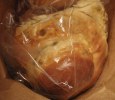 My round raisin challah
I haven't been posting much here on this weblog, but there has been some activity on SATN.org, including three posts I made this past week. I'm finishing a new essay I'll post here next week.
Memories while visiting the Bay Area and the Computer History Museum [link]
This past week I was in the San Francisco Bay Area for work. It was the first time I've been there since the September 11th time last year. Last year I flew out on an evening United flight September 10th. Luckily, I was supposed to be the first speaker on the morning of September 11th, or else I might have been on a morning flight from Boston to California September 11th to speak in the afternoon, a very sobering realization. Sitting in my hotel room this time, working on that same laptop, on a similar desk between a similar bed and a similar window, a strange, depressed feeling came over me. It wasn't until I inadvertently read my weblog postings from mid-September of last year that I realized the feelings were the memories of how everything was when I wrote them coming back. Weblogs really can be of value to the author as a diary. The acceptability of conveying personal feelings, something you may not see as frequently with other public publications, helps.
My parents are moving up to the Boston area soon, and as my Mother goes through the attic she keeps finding old "artifacts": Letters my Dad wrote when he was in the army, grandparents' marriage certificates, my report cards and SAT scores, etc. She is being flooded with memories and shares many of them with us over the phone (and we'll get to go through boxes ourselves of what she doesn't throw out). While out their I head of her latest "finds". I plan to go down to Philadelphia and photograph some of the material to add to my digital image collection. Somethings aren't worth keeping physically, but you'd like to remember what they were, so the photographs are a good compromise. In addition, I periodically give copies of my family digital files to other relatives so they can add them to their collections and so that the chances of the images being around for later generations increases.
I had an extra hour or two between appointments to stop in at the Computer History Museum at Moffett Field. I've been involved with the museum for years. The collection was originally in Boston, but has moved to California with a renewed focus on preservation and display of our industry's past. On the last few trips trips to the Bay Area I only managed one trip to the office -- this was my first trip to see larger parts of the collection since it moved.
It was really amazing for me. As I walked around the warehouse, just about every type of computer I'd ever used or read about was sitting right there. It was like a "this is your life" retrospective. (I'm ignoring the myriads of machines they have that weren't part of my life -- I just walked past them while running up to an "old friend".) Most looked just like they did when last used, with notes taped to the sides and pencil markings, ready for an operator to flip the next switch. There was a piece of ENIAC, an Enigma machine, an 029 card punch just like I used to use, a card sorter like the one my Mother's father showed me down the hall from his newspaper office that inspired an important science fair project for me, an IBM 1401, 1130, and 360/91 -- all computers I used or visited as a kid. There was a CDC 6600, a Xerox Alto and a Star, a PDP-1 (the type used for the first Space War "video game"), an Apple I, and a prototype breadboard Palm Pilot. I saw the computers friends worked on from old, dead companies. As I walked around, I took some pictures for my memories and to share with those friends. Now that computers are completely integrated into society, and we can look back and see what had influence to whom (without only caring what was financially successful and what wasn't-- they're all obsolete), the value of this museum is growing in importance. I've toured parts of Europe and seen items that influenced our Western culture (such as Galileo's tools in Florence), and I realize all sorts of people will care about this in the future to understand how we got were we are. Our challenge is how to preserve the artifacts and pass on the lessons learned. Here are some pictures:
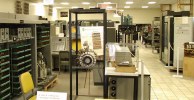   The corner of one of the rooms in one of the warehouses, some tubes on the back of ENIAC, an 029 keypunch
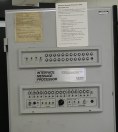  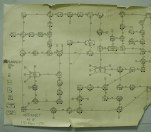 One of the first eight ARPANET Interface Message Processors, front and inside. This was from BBN and was installed June 1970. Today everyday people buy a router (the modern IMP) at Staples for the price of a pair of shoes. The diagram was taped to the side: "ARPANET as of 19-Nov-79" -- basically the whole Internet 23 years ago.
 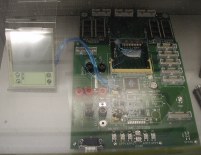 A Xerox Alto II which led directly to today's GUI PC world, and a breadboard of the first Palm Pilot, the first PDA that was really successful
|
||
|
© Copyright 1999-2018 by Daniel Bricklin
All Rights Reserved.
|
||